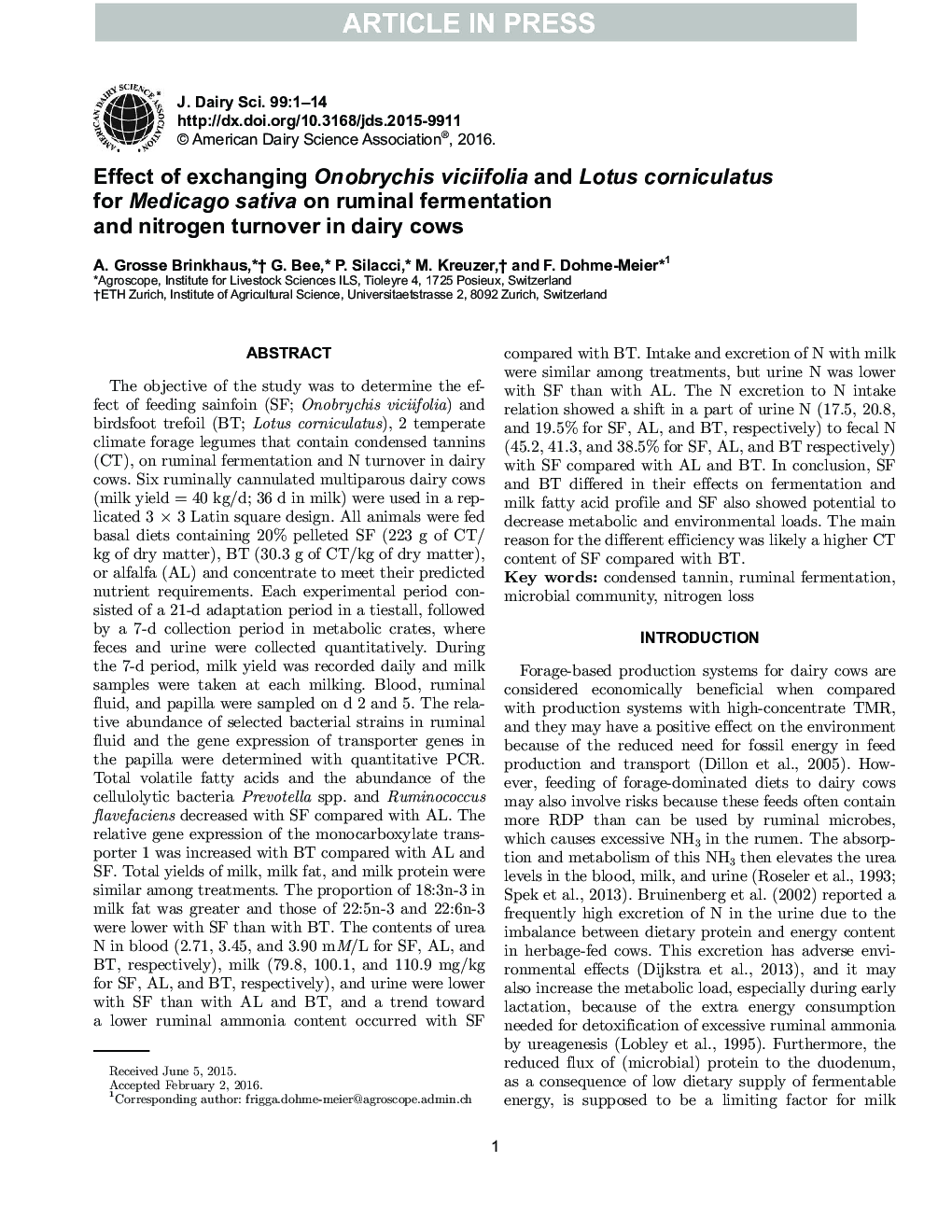| کد مقاله | کد نشریه | سال انتشار | مقاله انگلیسی | نسخه تمام متن |
|---|---|---|---|---|
| 10973304 | 1108013 | 2016 | 14 صفحه PDF | دانلود رایگان |
عنوان انگلیسی مقاله ISI
Effect of exchanging Onobrychis viciifolia and Lotus corniculatus for Medicago sativa on ruminal fermentation and nitrogen turnover in dairy cows
دانلود مقاله + سفارش ترجمه
دانلود مقاله ISI انگلیسی
رایگان برای ایرانیان
کلمات کلیدی
موضوعات مرتبط
علوم زیستی و بیوفناوری
علوم کشاورزی و بیولوژیک
علوم دامی و جانورشناسی
پیش نمایش صفحه اول مقاله

چکیده انگلیسی
The objective of the study was to determine the effect of feeding sainfoin (SF; Onobrychis viciifolia) and birdsfoot trefoil (BT; Lotus corniculatus), 2 temperate climate forage legumes that contain condensed tannins (CT), on ruminal fermentation and N turnover in dairy cows. Six ruminally cannulated multiparous dairy cows (milk yield = 40 kg/d; 36 d in milk) were used in a replicated 3 Ã 3 Latin square design. All animals were fed basal diets containing 20% pelleted SF (223 g of CT/kg of dry matter), BT (30.3 g of CT/kg of dry matter), or alfalfa (AL) and concentrate to meet their predicted nutrient requirements. Each experimental period consisted of a 21-d adaptation period in a tiestall, followed by a 7-d collection period in metabolic crates, where feces and urine were collected quantitatively. During the 7-d period, milk yield was recorded daily and milk samples were taken at each milking. Blood, ruminal fluid, and papillae were sampled on d 2 and 5. The relative abundance of selected bacterial strains in ruminal fluid and the gene expression of transporter genes in the papillae were determined with quantitative PCR. Total volatile fatty acids and the abundance of the cellulolytic bacteria Prevotella spp. and Ruminococcus flavefaciens decreased with SF compared with AL. The relative gene expression of the monocarboxylate transporter 1 was increased with BT compared with AL and SF. Total yields of milk, milk fat, and milk protein were similar among treatments. The proportion of 18:3n-3 in milk fat was greater and those of 22:5n-3 and 22:6n-3 were lower with SF than with BT. The contents of urea N in blood (2.71, 3.45, and 3.90 mmol/L for SF, AL, and BT, respectively), milk (79.8, 100.1, and 110.9 mg/kg for SF, AL, and BT, respectively), and urine were lower with SF than with AL and BT, and a trend toward a lower ruminal ammonia content occurred with SF compared with BT. Intake and excretion of N with milk were similar among treatments, but urine N was lower with SF than with AL. The N excretion to N intake relation showed a shift in a part of urine N (17.5, 20.8, and 19.5% for SF, AL, and BT, respectively) to fecal N (45.2, 41.3, and 38.5% for SF, AL, and BT respectively) with SF compared with AL and BT. In conclusion, SF and BT differed in their effects on fermentation and milk fatty acid profile and SF also showed potential to decrease metabolic and environmental loads. The main reason for the different efficiency was likely a higher CT content of SF compared with BT.
ناشر
Database: Elsevier - ScienceDirect (ساینس دایرکت)
Journal: Journal of Dairy Science - Volume 99, Issue 6, June 2016, Pages 4384-4397
Journal: Journal of Dairy Science - Volume 99, Issue 6, June 2016, Pages 4384-4397
نویسندگان
A. Grosse Brinkhaus, G. Bee, P. Silacci, M. Kreuzer, F. Dohme-Meier,